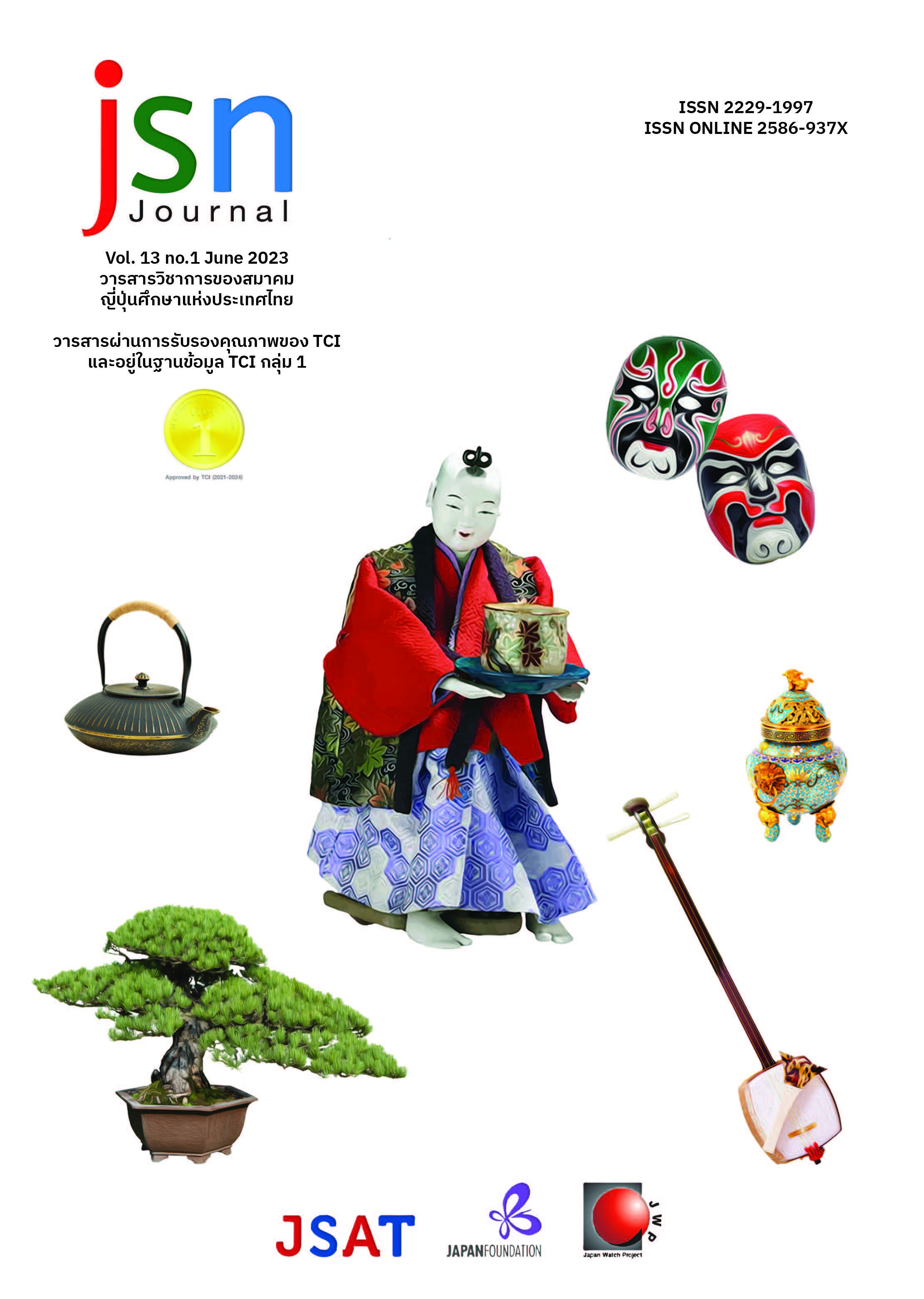From Atom to Eva: The development of Japanese animation production from 1963 to 1996
Main Article Content
Abstract
The purpose of this article is to investigate the development of Japanese animation production from 1963 to 1996 by examining the relationship between changes in animation content and its industry structure. This research uses the six-facet model of the production nexus to analyze data from the production of culture perspective. This study is based on documentary research and conducted a descriptive analysis focused on industry structure change. The study found that Japanese animation producers were able to evolve in response to changes in production contexts. By the late 20th century, they successfully produced engaging and diverse animations. Unique characteristics are funny stories and interesting motion pictures. Moreover, since the target audience is wide-ranging—from children to adults—the content is deeper and more diverse than animation from other countries. In addition, the Japanese animation industry is also focusing on selling licensed products, which are the main source of income for the animation industry. As a result of analyzing the relationship between changes in the animation content and industry structure, it was found that the structure of the animation industry can be divided into the following two types: 1) the sponsor and 2) the production committee. The sponsorship structure provided funding for the early stage of production, but the animation producers were under the influence of the sponsor. In contrast, the production committee structure is a joint venture group of companies involved in production activities. The latter structure gives animation producers more freedom to create a wider variety of animations. In summary, changes in the relationships among the actors in different production structures also affect changes in the animation content.
Article Details

This work is licensed under a Creative Commons Attribution-NonCommercial-NoDerivatives 4.0 International License.
ข้อความและข้อคิดเห็นต่างๆ ในบทความเป็นของผู้เขียนบทความนั้นๆ ไม่ใช่ความเห็นของกองบรรณาธิการหรือของวารสาร jsn Journal
References
จรรยา เหลียวตระกูล. (2540). พัฒนาการของการ์ตูนนำเข้าจากต่างประเทศที่ออกอากาศทางสถานีโทรทัศน์ไทยทีวีสีช่อง 9 อสมท. [วิทยานิพนธ์มหาบัณฑิต บัณฑิตวิทยาลัย]. จุฬาลงกรณ์มหาวิทยาลัย.
ชาติณรงค์ วิสุตกุล. (2543). ทัศนคติของวัยรุ่นชายต่อการ์ตูนญี่ปุ่นที่มีเนื้อหารุนแรงในสื่อสิ่งพิมพ์กับสื่ออิเล็กทรอนิกส์. [วิทยานิพนธ์มหาบัณฑิต คณะนิเทศศาสตร์]. จุฬาลงกรณ์มหาวิทยาลัย.
ชาริกา ชาญนันทพิพัฒน์. (2565). สร้างซอฟต์พาวเวอร์ มองเกมยาว เปิดกว้างการตีความ “ความเป็นไทย”. TDRI. http://tdri.or.th/2022/04/global-soft-power-index-2022.
นนทยา พงศ์ผกาย. (2544). การสื่อสารเรื่องความสัมพันธ์ระหว่างเพศในการ์ตูนญี่ปุ่น. [วิทยานิพนธ์มหาบัณฑิต คณะนิเทศศาสตร์]. จุฬาลงกรณ์มหาวิทยาลัย.
พีระ เจริญวัฒนนุกูล. (2561). พินิจแนวคิด Soft Power อย่างจริงจัง: ปัญหาและความเข้าใจผิดในการประยุกต์ใช้แนวคิดนี้ในงานวิชาการไทย. รัฐศาสตร์นิเทศ, 4(1-2), 237-277.
ลลิตา ยุวนากร. (2533). การวิเคราะห์เนื้อหาการ์ตูนสำหรับวัยรุ่นที่แปลจากภาษาญี่ปุ่น. [วิทยานิพนธ์มหาบัณฑิต คณะครุศาสตร์]. จุฬาลงกรณ์มหาวิทยาลัย.
วาสนา ปานนวม. (2555). การส่งเสริมการ์ตูนของญี่ปุ่น: เครื่องมือเพิ่ม Soft Power และผลประโยชน์ทางเศรษฐกิจ. วารสารญี่ปุ่นศึกษาธรรมศาสตร์, 29(1),76-85.
Alt, M. (2021). Pure Invention: How Japan's Pop Culture Conquered the World. New York: Penguin Random House LLC.
Aoyama, I. (2006). Doraemon come to Thailand: The process of appropriating a foreign cultural product. [Faculty of Arts]. Chulalongkorn University.
Becker, H. (1974). Art As Collective Action Author(s). American Sociological Review, 39(6), 767-776.
Condry, I. (2013). The Soul of Anime: Collaborative Creativity and Japan's Media Success Story. North Carolina: Duke University Press.
Janet, W. (1993). The Social Production of Art (2nd edition). New York: NYU Press.
JETRO. (2005). Japan Animation Industry Trends. Japan Economic Monthly, June.
http://www.made-in-asia-.webs.com.
Napier, S. (2004). Anime from Akira to Princess Mononoke: Experiencing Contemporary Japanese Animation.
New York: Palgrave.
Novielli, M.R. (2018). Floating worlds: a short history of Japanese animation. Florida: CRC Press.
Nye, J. J. (2004). Soft Power: the Means to Success in World Politics. New York: Public Affairs.
Peterson, R. and Anand,N. (2004). The Production of Culture Perspective. Annual Review of Sociology, 30, 311-334.
Poowin, B. (2012). The Internet: An (Other) Agent that Disseminates Japanese ‘Soft Power’ Resources. Journal of Contemporary Eastern Asia, 11(1), 21-29.
安達則嗣 (2010).「日本の商業アニメーションの軌跡に関する一考察--東映アニメーション(株)の業暦から見た日本の商業アニメーション」『芸術工学研究:九州大学大学院芸術工学研究院紀要』12, 1-25.
アニメ大全 (2022).「1万4710作品、アニメ総合データベース「アニメ大全」一般公開開始」, アニメーションビジネス・ジャーナル. http:// www.animationbusiness.info/archives/13605.
小黒祐一郎 (2009).「アニメ様365日[小黒祐一郎]第157回『DALLOS』」,WEBアニメスタイル誌.
http:// www.style.fm/as/05_column/365/365_157.shtml.
亀山泰夫 (2013).『アニメビジネスの特性分析と課題解決に向けた』東京:慶應義塾大学.
金子浩明 (2020).「『鬼滅の刃』仕掛け人 ソニーのアニメは三方よし戦略 」,日本経済新聞.
http://www.nikkei.com/article/DGXMZO65854710V01C20A1X12000.
黑沢哲哉 (2012).「手塚治虫、アニメにかけた情熱のルーツを綴る!!」, Tezuka Production. http://www.tezukaosamu.net/jp/mushi/201209/column.html.
斉藤守彦 (1997).「エヴァ……愛の迎撃 あるいは悲観的運命への抵抗」『キネマ旬報』1218, 43-47.
津堅信之 (2007a). 『アニメ作家としての手塚治虫-その軌跡と本質』東京:NTT出版.
津堅信之 (2007b). 『日本アニメーションの力―85年の歴史を貫く2つの軸』東京:NTT出版.
手塚治虫OFFICIAL (n.d.).「鉄腕アトム1952/04−1968/03」, Tezuka Production. https://tezukaosamu.net/jp/manga/291.html
古田尚輝 (2006).「アニメーション製作の企業化に関する一考察」『コミュニケーション紀要』18, 23-80.
山口旦訓・渡辺泰 (1977).『日本アニメーション映画史』広島:有文社.
山本映一 (1989).『虫プロ興亡記』東京:新潮社.
BSアニメ夜話 (2005).「『まるごと!機動戦士ガンダム』 第3部 激論!モビルスーツ 」,NHKBS2.
[Video]. Youtube. https://www.youtube.com/watch?v=up3SKHNXmQU.


